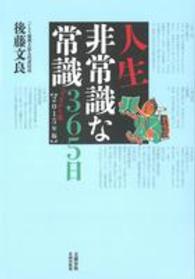Full Description
The songs of the Royal Zhou ("Zhou Nan" ) and of the Royal Shao ("Shao Nan" ) have formed a conceptual unit since at least the late Spring and Autumn period (771-453 BC). With this book Meyer and Schwartz provide a first complete reading of their earliest, Warring States (453-221 BC), iteration as witnessed by the Anhui University manuscripts. As a thought experiment, the authors seek to establish an emic reading of these songs, which they contextualise in the larger framework of studies of the Shi (Songs) and of meaning production during the Warring States period more broadly. The analysis casts light on how the Songs were used by different groups during the Warring States period.
Contents
Introduction1 The An Da Shi2 Attempting an 'Emic' Reading of the An Da Shi3 Writing the Image Programme of the Songs4 Bringing to Life the Sound Moulds of Shi Production5 Sounding the Image Programme of the Songs6 Receiving the Shi7 The Significance of the Royal Zhou and the Royal Shao8 What Does 'Nan' Mean?9 The Significance of the An Da Shi10 The Songs of the Royal Zhou and the Royal Shao: ConventionsSongs of the Royal Zhou and the Royal ShaoSongs of the Royal Zhou1 List of Songs2 Zhou Nan 1 3 Zhou Nan 2 4 Zhou Nan 3 5 Zhou Nan 4 6 Zhou Nan 5 7 Zhou Nan 6 8 Zhou Nan 7 9 Zhou Nan 8 10 Zhou Nan 9A 11 Zhou Nan 9B 12 Zhou Nan 11 Songs of the Royal Shao1 List of Songs2 Shao Nan 1 3 Shao Nan 2 4 Shao Nan 3 5 Shao Nan 4 6 Shao Nan 5 7 Shao Nan 6 8 Shao Nan 7 9 Shao Nan 8 10 Shao Nan 9 11 Shao Nan 10 12 Shao Nan 11 13 Shao Nan 12 14 Shao Nan 13 15 Shao Nan 14 BibliographyIndex








